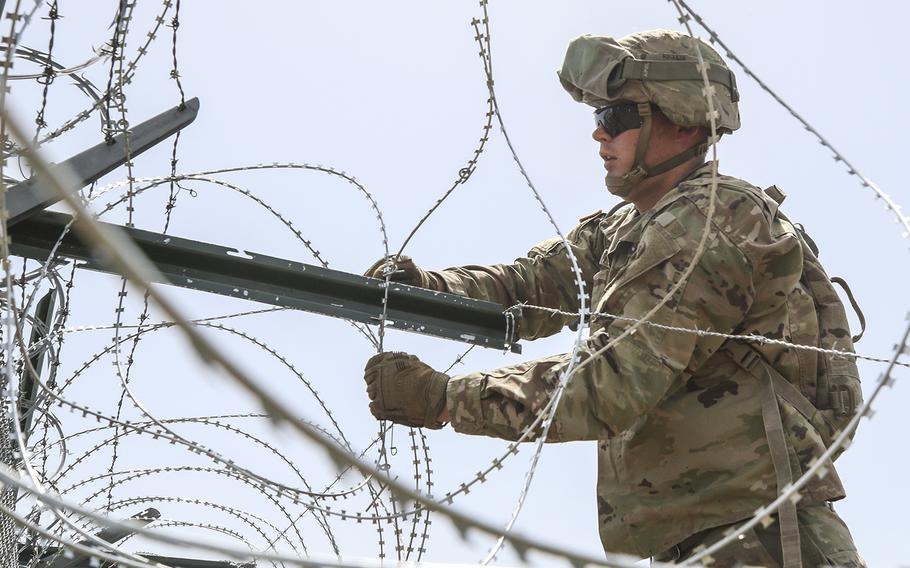
A soldier from the 161st Engineer Support Company (Airborne) secures concertina wire to the existing border fence near the World Trade International Bridge in Laredo, Texas, April 11, 2019. (Andrew S. Valles/U.S. Army)
WASHINGTON — The Pentagon will expand the military’s mission along the southern border, sending nearly 300 additional active-duty troops there who will be authorized to have direct contact with migrants entering the United States to provide them food and shuttle them between locations, defense officials said Friday.
Acting Defense Secretary Pat Shanahan on Friday was expected to approve a request for assistance from the Department of Homeland Security to deploy the new troops in the coming days, said Charlie Summers, the Pentagon’s acting chief spokesman. The new troops will include some 160 drivers, about 100 support troops – mostly cooks – and about 20 lawyers.
The new deployment will bring the number of active-duty troops operating along the southern border in Texas, New Mexico, Arizona and California to about 3,200. Another roughly 2,000 National Guard troops are also serving deployments along the border in a separate, but related, mission to support Customs and Border Protection agents.
Summers said the new missions that place troops in direct contact with migrants did not represent an official change to the Pentagon’s long-standing operating procedures, which barred its troops from contact with migrants, unless that contact was to deliver emergency medical aid. He said the amendment to the operating procedures, which date back to at least 2006, was written into the DHS request to Shanahan and only applied to the newly deploying troops.
“In the past, we have had absolutely no contact [with migrants] but because we are handing the meals to them, we are delineating,” Summers said, pushing back on reporting Friday by the Washington Post, which described the policy exemptions as waivers.
The expanded role at the border for the military would not include law enforcement operations, Summers said. The military is barred from conducting law enforcement missions on U.S. soil by the 1878 Posse Comitatus Act.
Summers said the new deployment was necessary because Border Patrol agents at certain locations have been inundated with arriving migrants and need additional bodies to deliver food or drive the migrants from one location to another. He declined to identify where the newly deploying troops would be sent.
“Our policy has always been that we are in support [of Customs and Border Protection] and there to monitor,” he said. “We are just saying that in this case in patrol stations where the CBP is overwhelmed our people will deliver meals to migrants.”
DHS officials have said the influx of Central American migrants arriving in recent weeks at the border has nearly reached a “breaking point” for CBP. In March, more than 103,00 migrants were processed at the border, DHS reported. It was the largest total of migrant processing for a month in 12 years, according to CBP. President Donald Trump’s administration has said it expects 150,000 migrants to be processed in April.
Summers on Friday declined to say how much money the new deployment would cost American taxpayers, but the Washington Post reported it could cost an estimated $21.9 million through the end of fiscal year 2019, citing internal Pentagon documents that the newspaper obtained.
The U.S. military’s border mission was initially ordered by Trump in the lead up to the 2018 mid-term elections as a large group of Central American migrants moved slowly toward the United States to seek asylum. In the months American troops have served there they have built temporary barriers, shuttled CBP agents via helicopter, conducted surveillance, and provided logistical support to CBP.
Military officials said earlier this month that the operations – the active-duty and National Guard missions – will cost at least $500 million through the end of the fiscal year. The active-duty mission is authorized through the end of fiscal year 2019, which ends Sept. 30. Outside estimates, including by the Washington-based think tank Center for Strategic and International Studies, indicate the border missions’ price tag could reach $1 billion by that date.
dickstein.corey@stripes.com Twitter: @CDicksteinDC